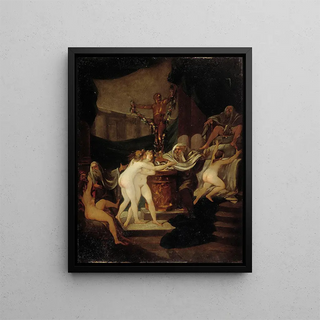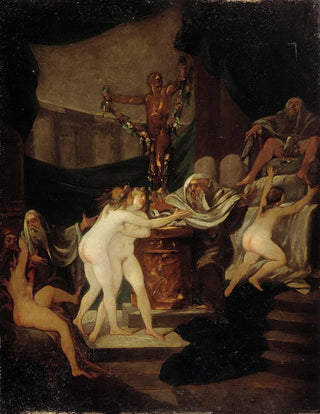Art print La Fête de Bacchus - Alexandre-Évariste Fragonard


View from behind

Frame (optional)
La Fête de Bacchus - Alexandre-Évariste Fragonard – Captivating Introduction
Immerse yourself in a festive and intoxicating universe with "La Fête de Bacchus" by Alexandre-Évariste Fragonard, transporting us to the heart of ancient celebrations. This artwork, imbued with a joyful atmosphere and palpable sensuality, evokes Roman mythology through the iconic figure of Bacchus, the god of wine and revelry. Fragonard, with his unparalleled mastery of colors and forms, succeeds in capturing the very essence of joie de vivre, offering a vibrant and dynamic representation of human exuberance. The scene, populated with cheerful characters, invites us to share a moment of conviviality and pleasure, while immersing us in a lush landscape where nature and art meet.
Style and uniqueness of the work
The piece stands out for its rococo style, characterized by flowing curves and dynamic compositions. Fragonard, a true virtuoso, uses a palette of vivid colors that breathe new life into each figure. Joyful faces, expressive gestures, and light drapery create an atmosphere of perpetual movement, as if the figures are about to step out of the painting to mingle with us. This play of light and shadow, accentuated by touches of golden light, enhances the sensual and festive dimension of the scene. The richness of details, from accessories to clothing, reflects meticulous attention to the depiction of the customs of his time, while celebrating pleasure and beauty in all their forms.
The artist and his influence
Alexandre-Évariste Fragonard, descended from a family of artists, established himself as one of the masters of the 18th century. A pupil of François Boucher, he inherited a particular sensitivity for the beautiful and the ephemeral, traits that are evident in his works. His style, both delicate and lively, influenced many artists of his era, as well as future generations. Fragonard managed to blend classical tradition with rococo innovations, creating a bridge between two artistic periods. His ability to express

Matte finish

View from behind

Frame (optional)
La Fête de Bacchus - Alexandre-Évariste Fragonard – Captivating Introduction
Immerse yourself in a festive and intoxicating universe with "La Fête de Bacchus" by Alexandre-Évariste Fragonard, transporting us to the heart of ancient celebrations. This artwork, imbued with a joyful atmosphere and palpable sensuality, evokes Roman mythology through the iconic figure of Bacchus, the god of wine and revelry. Fragonard, with his unparalleled mastery of colors and forms, succeeds in capturing the very essence of joie de vivre, offering a vibrant and dynamic representation of human exuberance. The scene, populated with cheerful characters, invites us to share a moment of conviviality and pleasure, while immersing us in a lush landscape where nature and art meet.
Style and uniqueness of the work
The piece stands out for its rococo style, characterized by flowing curves and dynamic compositions. Fragonard, a true virtuoso, uses a palette of vivid colors that breathe new life into each figure. Joyful faces, expressive gestures, and light drapery create an atmosphere of perpetual movement, as if the figures are about to step out of the painting to mingle with us. This play of light and shadow, accentuated by touches of golden light, enhances the sensual and festive dimension of the scene. The richness of details, from accessories to clothing, reflects meticulous attention to the depiction of the customs of his time, while celebrating pleasure and beauty in all their forms.
The artist and his influence
Alexandre-Évariste Fragonard, descended from a family of artists, established himself as one of the masters of the 18th century. A pupil of François Boucher, he inherited a particular sensitivity for the beautiful and the ephemeral, traits that are evident in his works. His style, both delicate and lively, influenced many artists of his era, as well as future generations. Fragonard managed to blend classical tradition with rococo innovations, creating a bridge between two artistic periods. His ability to express
12,34 €






